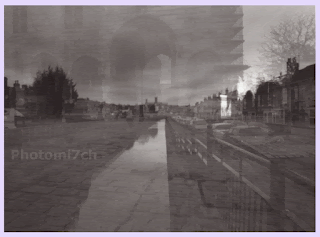It
is always a joy to be out with the Pinhole camera. But
it must be a strange sight to behold as I walk up the street. A
little brown box attached to what could be construed as a big black
stick (tripod). On this occasion it was a lovely bright day with a
biting cold wind; I had not appreciated just how cold it was
until I had been standing about
making the first image.
As
I strolled around the local lakes I took warmth from the brilliant
sunshine and the anticipation of some interesting image making. By
the time I was half a dozen pictures in I had forgotten how cold I
was. I think the cold must have gotten to me as I could not remember
what the reciprocity factor should be. Times 2 up five seconds and
times 5 from then on. Dam and I had left my note book behind with the
reminders in. Oh well I'm not going back.
 |
| from T max negative |
This
walk is turning to a bit of a jokers holiday which had started before
I had even left the house. My Zero is a multi format camera Just
before I loaded the film I checked to see where the dividers were and
in my mind it was set to 6x6 I loaded the film and used the centre
red window to view the frame count. I should explain there are three
for the different sizes of negative. Later that day I had the chance
to develop the film only to find it was set to 6 x 4.5 – ehh!
Fortunately the second film was only part way through so rectified it
by using the top window for the next days images.
The
wind was that strong it was producing lots of fine ripples across the
water. I was not quit sure how this would look in the final images
not having made many photos of water with this camera. It just go's
to show how cold it was, on the eastern side of the lake I found a
lot of glass thick ice being smashed up on the shore. This brought
back how cold I was feeling. Time to get back, to a home made slow
cooked beef Currie that should be bubbling away by now.
 |
Contact print at 2 seconds
the print is
also showing signs
of exhausted fix. |
Just
before I left the house the following day I filled my pocket with a
mix of film from different manufacturers; I do not usually do this
but so what! it was an off the cuff decision to go out picture making
so why not mix it up completely! The previous day I had already
loaded Kodak's T Max 400 which I thought might be a bit of a gamble
seeing how bright it was, just as well I did, as I messed up the
exposure completely. On subsequent trips I loaded Ilford's delta 100
and Fomapan 100 which is my fav film for the Zero. The others were
first time use and this time I got the exposure right.
How
badly the T Max was exposed showed it self when I contact printed the
negatives. I had to re do it at 5 sec's instead of my usual 2,
enlarging lens fully open with white light (with no grade filters
set). The negatives when looked at showed full detail. The contact
print indicated that the enlargement were going to need long
exposures and a lot of dodging to get them the way I wanted.
 |
| From Fomapan 100 negative |
I
have developed all my negatives in Adox version of Rodinal. I use
1+50 for the time required. I have to keep reminding myself that this
developer has a high acutance and therefore a lot more contrast. In
some cases overly so. I had in mind to use Kentmere RC gloss but
changed to Footspeed's RC gloss that has a more normal look. If I had
kept to the original route they would have had super contrast. As it
was, I had to drop the filtration for printing down to 0 from my
normal grade 3 . With the contrast sorted it was time for the
exposures. With the segmented test print in the holding tray the fun
really started. As an example one print had a base exposure of twenty
seconds but then needed an extra 40 seconds on top of that for the
sky and some of the lake. Others longer.
 |
| From Ilford delta 100 negative. |
I
had a good time in the darkroom even though the printing sessions
were challenging the prints came out a lot better than expected. They
have a lot of atmosphere to them that I'm really pleased about. Some
of the photographs show that there is ice on the lake in places. I
was not sure if that would show up but it has in a couple of the
images.


















































